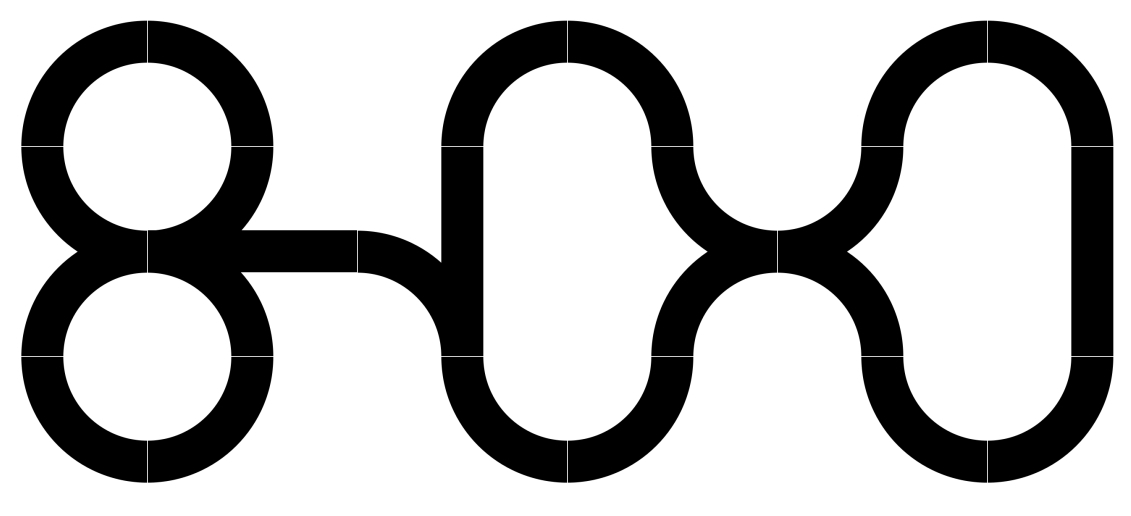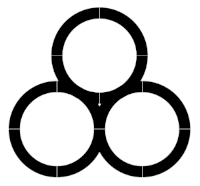Process
There is a scene in Neal Stephenson’s Ananthem of an old adept covering a floor area with eccentric shaped tiles. I started looking into tiling patterns which lead to designing a game which eventually the basis for the work.
The game pieces are paper square with lines printed on them. The three primitives are a straight line from the midpoint of one side to the midpoint of the opposite side, a quarter circle line from midpoint of a side side to the midpoint of the adjacent side, and an inside corner with a line from a the midpoint of a side to the center and then to the midpoint of the adjacent side. Other tiles are a combination of two or three primitives such as a “y” with two curved lines starting at the middle of the same side and ending at the opposite adjacent sides or a “t” with a straight line overlaid by a straight curve.
The game is to design the largest continuous track where all squares within a perimeter are filled and all parts of the track can be transversed in either direction without stopping and changing direction.
What I thought would be a complicated task resolved into a simple one. All that's needed is one switching arrangement which ensures bi-directionality and attention to preventing trap loops where there's one way in but no way out.
-

Bi-directional switching
-

Trap on the left side
The two basic bi-directional switching arrangements are a figure 8 within an oval and an oval pinched in the middle. There are others, but they generally resolve down to one of these two. The key is to provide straight paths from one loop to the other to break the circular motion. A simple trap is a figure eight. There’s one way to enter the figure eight but there’s no way to exit without stopping and changing direction of flow.
This was the impetus for the Tracks graphic prints. Create maps, overlay maps, add color. The rules are the same as for the game - create compliant bi-directional patterns then modify. So while the results may not be compliant, the modifications were made in the spirit of maintaining compliance.
Thoughts

It struck me that the trap configuration, or the leminscate representing infinity, may not be the best way to represent infinity because there is only one direction of travel. The bi-directional loop perhaps expresses infinite more fully, allowing for smooth direction shifting and therefore more possibilities. Or to take it a step further, the infinite of the three circles suggests a trinary system, rather than binary.
This inevitably led to questions about order and premeditation. What happens at the switch point. Is it arbitrary or determined?
I identified four descriptors of the state of order: random, chaos, system, and arbitrary. Random is the complete lack of order. Chaos looks random but there's an underlying ordering mechanism, such as an atrractor, which, if found, tames the apparent randomness. When the attractor becomes strong enough, the randomness is removed into a predictable system. The system can be tweaked or broken by arbitrary action, either systemically, chaotically, or randomly.
Systems put into question the idea of free will. If systems control all actions, then future outcomes are predetermined, whether they are perceivable or not. The perception of free will at one level may be an outcome predetermined at a higher (or lower) level of abstraction. It becomes a Russian doll condundrum.
At the current state of knowledge, the nature of free will, or independent agency, is a matter of belief. I believe that we are alive in a chaotic universe where there is the capability for independent agency but where the energy cost of agency is such that most of the time we allow the chaotic structure(s) to determine choices and outcomes.
From this comes the idea that arcane, shaministic knowledge is the result of not just pursuing independent agency, but examing the process of agency, thereby gaining insight into the nature and operation of the chaotic structure(s). Without agency, the structure(s) operate imperceptably. With agency, free will action is possible. Only with agency about agency can the structure(s) become apparent.
An apparent paradox is that once agency agency is attained, the energy required to maintain that state drops. It's like the expenditure of energy required to jump from one state to another, but once at the new state, energy is not required to stay there.
Tracks, then, bounce back and forth between abstract and representation chasing the idea of arcane knowledge.